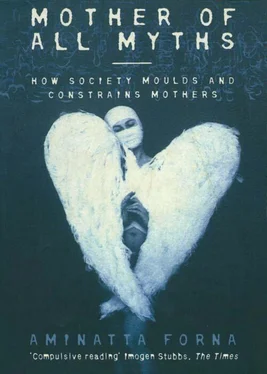Bowlby elaborated all kinds of emotional, psychological and character disorders which could result from maternal deprivation, from the creation of full-blown psychopaths to adults unable to function properly in their own relationships. Deprivation had many causes, including a child’s stay in hospital. Ignoring a crying child counted as partial deprivation, this last much to the consternation of a generation of women who had followed the diktats of Truby King with their own children.
All the attention mothers were required to lavish upon their children facilitated their proper ‘attachment’ to each other. Bowlby was an early fan of ethology and from his readings on the behaviour of birds and monkeys, specifically ideas about imprinting (the way newborn animals automatically follow their mother), he concluded that an infant’s attachment to its mother was both natural and instinctive.
Fathers, it will be no surprise to hear, once again had no significant role, save as earners. By placing so much emphasis on mothers and arguing that attachment was instinctive and natural, Bowlby left little for fathers who have struggled to find a place in their children’s lives ever since. Bowlby himself was a father of four who, by all accounts, left the care of his children entirely up to his wife Ursula.
Bowlby’s theories were seized upon and his conclusions, based on extreme situations, were glibly applied to the everyday. It is clear, too, that Bowlby himself, in his zeal, overstated his case. An immediate consequence was panic among women terrified they had already damaged children – an anxiety he was obliged to quell by softening his message slightly in later writings.
Another far more serious consequence was Bowlby’s success in achieving the closure of not only the orphanages he loathed, but the vast proportion of nurseries and daycare centres which had opened up, with government approval and funding, during the war. In 1944 there were 1,559 nurseries in Britain catering to tens of thousands of children, but after the war the nurseries became an expensive wartime legacy for the government, which was also under pressure to provide jobs for thousands of returned soldiers. In 1951, in response to Bowlby’s commissioned report, a WHO report claimed that nurseries and daycare ‘cause permanent damage to the emotional health of a generation’. 8 Bowlby’s findings swiftly became official policy. By the early 1950s virtually all the wartime nurseries had gone. It became accepted wisdom among health professionals, social workers and teachers that working mothers ran the risk of damaging their children.
It has been suggested by some historians and writers that more than a whiff of conspiracy surrounds what appears to be the remarkably fortuitous timing of mutually expedient concerns. From the point of view of the government, there does appear to be some truth in the suggestion that they had more in mind than the happiness of infants when they embraced Bowlby’s theories so readily. But Bowlby probably also imagined he was elevating the status of mothers by bestowing on their task so much importance, rather than simply driving women back into the home. It is easy to see how his theories could have been a soft sell to plenty of women. Many had witnessed or experienced the wartime shattering of their families. They wanted time to re-establish relationships with their children and their husbands. These were the babyboom years when not only cities and economies were being rebuilt, but families too. Postwar prosperity in Britain, helped by billions of dollars of Marshall Plan aid from America, meant that even blue-collar workers could earn enough to keep a wife and family.
It is illuminating to see how certain of Bowlby’s recommendations were taken up, while others were ignored. Bowlby was opposed to mothers with young children going out to work at all. Previously most nurseries were perfectly prepared to accept two-year-olds, but soon, thanks to Bowlby’s warnings, they would only take children from the age of five. Bowlby, however, did recognize that most women who worked did so because they needed the money. By way of compensation he suggested a wage for housework to be paid by the government to mothers, to encourage and enable them to stay at home – a proposal that never made it to the statute books.
The train Bowlby set on track gathered pace in the years that followed. In time, researchers began to focus not just on the mother’s relationship with her child, but even on her competence. Selma Fraiberg, a Bowlby devotee, invented a method for measuring a child’s attachment to the mother and declared that children whose mothers were not sufficiently skilled or attentive were poorly attached and would grow up insecure. In her immensely popular 1959 book The Magic Years, she argued that nothing less than twenty-four-hour devotion would do, and that being cared for by persons other than their mother was actually harmful to infants. Notably, her calls for financial support for mothers to stay at home also went unheeded.
So the 1950s mother was actually Pygmalion mum, the result of one man’s vision of the perfect mother. For a mixture of social and economic reasons, Bowlby’s ideal of the loving, selfless, stay-at-home supermum became, and still is to this day, the established view of what constitutes ‘normal’ mothering. Motherhood became transformed into a rigid, rule-laden process, governed by dogma produced by so-called experts whose views were always framed in terms of what was best for baby, placing them beyond debate. By being so inflexible and so extreme in the application of ideas which had started as guiding principles, the new professionals put the interests of mothers and their children into conflict.
Typically, far more attention is paid to a controversial or radical new theory than to the subsequent critiques. If Bowlby and his followers were accepted uncritically by the general public, within his profession his views prompted no small degree of controversy. Many other critics came from fields outside psychoanalysis such as ethology, sociology and anthropology. One of his critics was the world-famous anthropologist Margaret Mead who had spent years chronicling childrearing methods in Samoa, Bali and the United States and elsewhere. She dismissed his ideas on the need for exclusive mothering and his ideas about attachment. Others pointed to aspects of Bowlby’s research, in particular the methods he used, which would never meet the standards required of scientific studies today. He rarely, for example, used control groups to measure his findings or looked for other possible causes.
Perhaps the main and most constant criticism is that while Bowlby claimed to be making a study of the effects of ‘maternal deprivation’ on children, what he was really looking at were the results of institutionalization. The children whose case histories make up the bulk of his work were deprived of everything, including ordinary human contact and any kind of affection. They were placed in huge orphanages and had dozens of carers who often provided poor care. Many had suffered some kind of distress in the form of family conflict, or wartime loss, others had been abused. Simply put, these were deeply unhappy children.
The British psychiatrist Michael Rutter has significantly revised and rethought many of Bowlby’s ideas. In his 1972 book Maternal Deprivation Reassessed, he shows that some of the symptoms of ‘maternal deprivation’ which Bowlby described, in particular stunted growth and poor speech development, had far more mundane roots. The children did not grow properly because of their meagre, vitamin-depleted orphanage diet, not because they lacked a mother’s love. Similarly, they had poor vocabularies because of their environment, not their parenting. Indeed, children in large families often display the same problem. As for maternal deprivation creating ‘affectionless psychopaths’, Rutter showed that children whose mothers had died did not become delinquents. The root causes of criminal behaviour in children lay elsewhere.
Читать дальше












